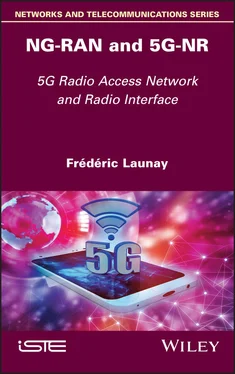1 Cover
2 Title Page
3 Copyright First published 2021 in Great Britain and the United States by ISTE Ltd and John Wiley & Sons, Inc. Apart from any fair dealing for the purposes of research or private study, or criticism or review, as permitted under the Copyright, Designs and Patents Act 1988, this publication may only be reproduced, stored or transmitted, in any form or by any means, with the prior permission in writing of the publishers, or in the case of reprographic reproduction in accordance with the terms and licenses issued by the CLA. Enquiries concerning reproduction outside these terms should be sent to the publishers at the undermentioned address: ISTE Ltd 27-37 St George’s Road London SW19 4EU UK www.iste.co.uk John Wiley & Sons, Inc. 111 River Street Hoboken, NJ 07030 USA www.wiley.com © ISTE Ltd 2021 The rights of Frédéric Launay to be identified as the author of this work have been asserted by him in accordance with the Copyright, Designs and Patents Act 1988. Library of Congress Control Number: 2021935849 British Library Cataloguing-in-Publication Data A CIP record for this book is available from the British Library ISBN 978-1-78630-628-9
4 Preface
5 1 NG-RAN Network – Functional Architecture
1.1. Functional architecture NSA/SA 1.2. Description of the NG-RAN network 1.2. Description of the NG-RAN network The NG-RAN provides both NR and LTE radio access. An NG-RAN node is either a gNB (5G base station), providing NR user plane and control plane services, or an ng-eNB (new generation 4G base station) providing the LTE/E-UTRAN services towards the UE (control plane and user plane). The NG-RAN ensures the connection of mobiles and the reservation of radio resources between: 1 – the mobile and the ng-eNB base station on a single 4G carrier (LTE) or on several 4G frequency carriers (LTE-Advanced); 2 – the mobile and the gNB base station on one or more 5G frequency bands (5G-NR). The gNBs and ng-eNBs are interconnected through the Xn interface. The gNBs and ng-eNBs are also connected, via NG interfaces, to the 5G core (5GC). The NG interface is the point of reference between the NG-RAN and the 5G core network: 1 – the NG-C interface is the interface between the radio node and the AMF (Access and Mobility Management Function). It supports signaling via NG-AP (Next Generation Application Protocol); 2 – the NG-U interface is the interface between the radio node and the UPF (User Plane Function) for tunneling traffic (the IP packet) via GTP-U (GPRS Tunneling Protocol). The UPF is configured by the SMF (Session Management Function) under the control of the AMF. Figure 1.6. NG-RAN general architecture The mobile exchanges data with the DN (Data Network) through logical connections called PDU (Protocol Data Unit) sessions. This logical connection is divided into two parts: 1 – the NG-RAN ensures the connection of the mobiles with the base station and interconnects the control plane and user plane (traffic) of the mobile UE with the core network; 2 – the 5G core network interconnects the NG-RAN, provides the interface to the DN, ensures the registration of mobiles, the monitoring of their mobility and the establishment of data sessions with the quality of the corresponding QoS (Quality of Service).
1.3. Functional separation between the NG-RAN radio interface and the 5G core network 1.3. Functional separation between the NG-RAN radio interface and the 5G core network The AMF is in charge of managing the 5G core network and services. It authenticates and registers each mobile and manages their mobility. Once registered, the AMF authorizes services according to the user’s profile. Figure 1.7 summarizes the functions managed on the NG-RAN and on the 5GC. Figure 1.7. The functional separation between NG-RAN and 5GC
1.4. Scheduling and QoS 1.5. Security architecture 1.6. Network slicing 1.7. References
6 2 NG-RAN Network – Protocol Architecture2.1. The protocol architecture of the radio interface 2.2. Procedures on the radio network access 2.3. Identities of the XnAP and NG-AP application protocols 2.4. References
7 3 NG-RAN Network – Procedures3.1. General procedure of the 5G-NSA mode 3.2. General procedures of the 5G-SA 3.3. References
8 4 5G-NR Radio Interface – The Physical Layer4.1. 5G-NR radio interface 4.2. TDD mode configurations 4.3. Physical resource 4.4. Physical channels and physical signals 4.5. Downlink transmission 4.6. Transmission in uplink 4.7. References
9 5 5G-NR Radio Interface – Operations on the Frequency Bands5.1. Operations on the frequency bands 5.2. Carrier aggregation 5.3. Supplementary UpLink (SUL) 5.4. Synchronization on the secondary cell 5.5. References
10 6 5G-NR Radio Interface – MIMO and Beamforming6.1. Multiplexing techniques 6.2. Antenna port 6.3. Uplink Control Information (UCI) 6.4. PDSCH transmission 6.5. PUSCH transmission 6.6. Beamforming management 6.7. References
11 7 5G-NR Radio Interface – Bandwidth Part7.1. Bandwidth part 7.2. CORESET 7.3. BWP switching procedure 7.4. References
12 8 5G-NR Radio Interface – Data Link Layer 8.1. SDAP protocol 8.2. PDCP 8.3. RLC protocol 8.4. MAC protocol 8.5. References
13 9 5G-NR Radio Interface – Radio Access Procedure9.1. System information 9.2. Connection management 9.3. Measurement configuration 9.4. References
14 Index
15 End User License Agreement
1 Cover
2 Table of Contents
3 Title Page
4 Copyright First published 2021 in Great Britain and the United States by ISTE Ltd and John Wiley & Sons, Inc. Apart from any fair dealing for the purposes of research or private study, or criticism or review, as permitted under the Copyright, Designs and Patents Act 1988, this publication may only be reproduced, stored or transmitted, in any form or by any means, with the prior permission in writing of the publishers, or in the case of reprographic reproduction in accordance with the terms and licenses issued by the CLA. Enquiries concerning reproduction outside these terms should be sent to the publishers at the undermentioned address: ISTE Ltd 27-37 St George’s Road London SW19 4EU UK www.iste.co.uk John Wiley & Sons, Inc. 111 River Street Hoboken, NJ 07030 USA www.wiley.com © ISTE Ltd 2021 The rights of Frédéric Launay to be identified as the author of this work have been asserted by him in accordance with the Copyright, Designs and Patents Act 1988. Library of Congress Control Number: 2021935849 British Library Cataloguing-in-Publication Data A CIP record for this book is available from the British Library ISBN 978-1-78630-628-9
5 Preface
6 Begin Reading
7 Index
8 End User License Agreement
1 Chapter 1 Figure 1.1. Deployment in the SA mode Figure 1.2. NSA configuration options Figure 1.3. Secondary node addition – option 3 Figure 1.4. NE-DC architecture – option 4 Figure 1.5. NE-DC architecture – option 7 Figure 1.6. NG-RAN general architecture Figure 1.7. The functional separation between NG-RAN and 5GC Figure 1.8. The fields of the SUCI identifier Figure 1.9. The fields of the 5G-GUTI identifier Figure 1.10. QFI management in the user’s plane Figure 1.11. Security architecture Figure 1.12. Ciphering and integrity
2 Chapter 2 Figure 2.1. Protocols on the 5G interface Figure 2.2. Processing of IP packet in the DataLink layer Figure 2.3. The structure of the radio interface Figure 2.4. The protocol stack of the Xn interface Figure 2.5. Interfaces between gNB entities and gNB-CU/gNB-DUs Figure 2.6. Virtualization of radio access Figure 2.7. NG-RAN architecture: distributed and centralized Figure 2.8. gNB-CU and gNB-DU functional decomposition options Figure 2.9. Functions of the physical layer Figure 2.10. Protocol stack of the control plane between the mobile and SMF func...
Читать дальше












